9 lessons from this year’s Chelsea Flower Show
In the final instalment of my Chelsea coverage, I reflect on what I’ve learned
The sun is shining, the bees are buzzing, and Main Avenue is humming with throngs of happy showgoers.
And the air feels lighter. The medals have been awarded; the special prizes for Best in Show and People’s Choice have been decided; the circus of celebrities and royals, society folk and glitterati has been and gone, replaced by an altogether more pleasant and less pretentious public. It’s as if the flower show, and all of its constituents have breathed a collective sigh of relief.
When I arrived on Monday – my first time stepping onto the Chelsea showground – I didn’t really know what to expect. Well, gardens I suppose. Lots of them. Interesting planting combinations, too. And in a variety of ways, and to varying degrees, these expectations have been met.
But what have I learned? What will I take home with me from this experience, other than a sore lower back and blisters on the backs of my heels?
Here are my main takeaways, following a week at the greatest flower show on Earth.
Lesson #1: The Showground Planting deserves a gold medal
It’s the set-dressing, the padding, the incidental ornamentation, but for me, it has been one of the highlights of my Chelsea experience: the so-called Showground Planting.
It is everywhere. Occupying the transitions between show gardens, beautifying the verges along the sides of avenues, framing the entrance to the toilets. But as natural as it seems, the showground planting – just like the show gardens themselves – has been carefully considered and specially installed, just for this event.
It is varied and site specific. Sunny corners sparkle with bold floral displays; tree-shaded walkways are lined with cool woodland planting. As a visitor, it slows you down, gives you something to look at and enjoy between the star attractions. In the same way that a well-chosen accessory can elevate an outfit, or a backing singer’s harmonising can enhance a pop star’s performance, for me, the showground planting makes the show gardens themselves feel more at-home, and better connected to one another and to their surroundings. Hats off to VaRa Garden Design, the design duo responsible.
Lesson #2: If you build it, they will come
“Were the bees brought in especially?” said the visitor to the volunteer.
“No, they’re just here for the flowers.”
At the bottom of Main Avenue sits the snappily titled ‘BBC Studios Our Green Planet and RHS Bee Garden’, designed by Joe Swift. As the name suggests, the garden’s stated purpose is to highlight the plight of pollinators, and the urgent need for us humans to create havens for bees and their insect friends in our gardens. And you know what, it is absolutely swarming with bees.
You couldn’t fake it. It’s not like you can release a barrel-load of bees into a show garden and expect them to stay. The bees are here in Joe Swift’s garden not because they saw him on the Gardeners’ World coverage and thought it would be fun to hang about; they’re just here for the flowers. It’s a simple, optimistic truth.
Lesson #3: No-one gets near Monty
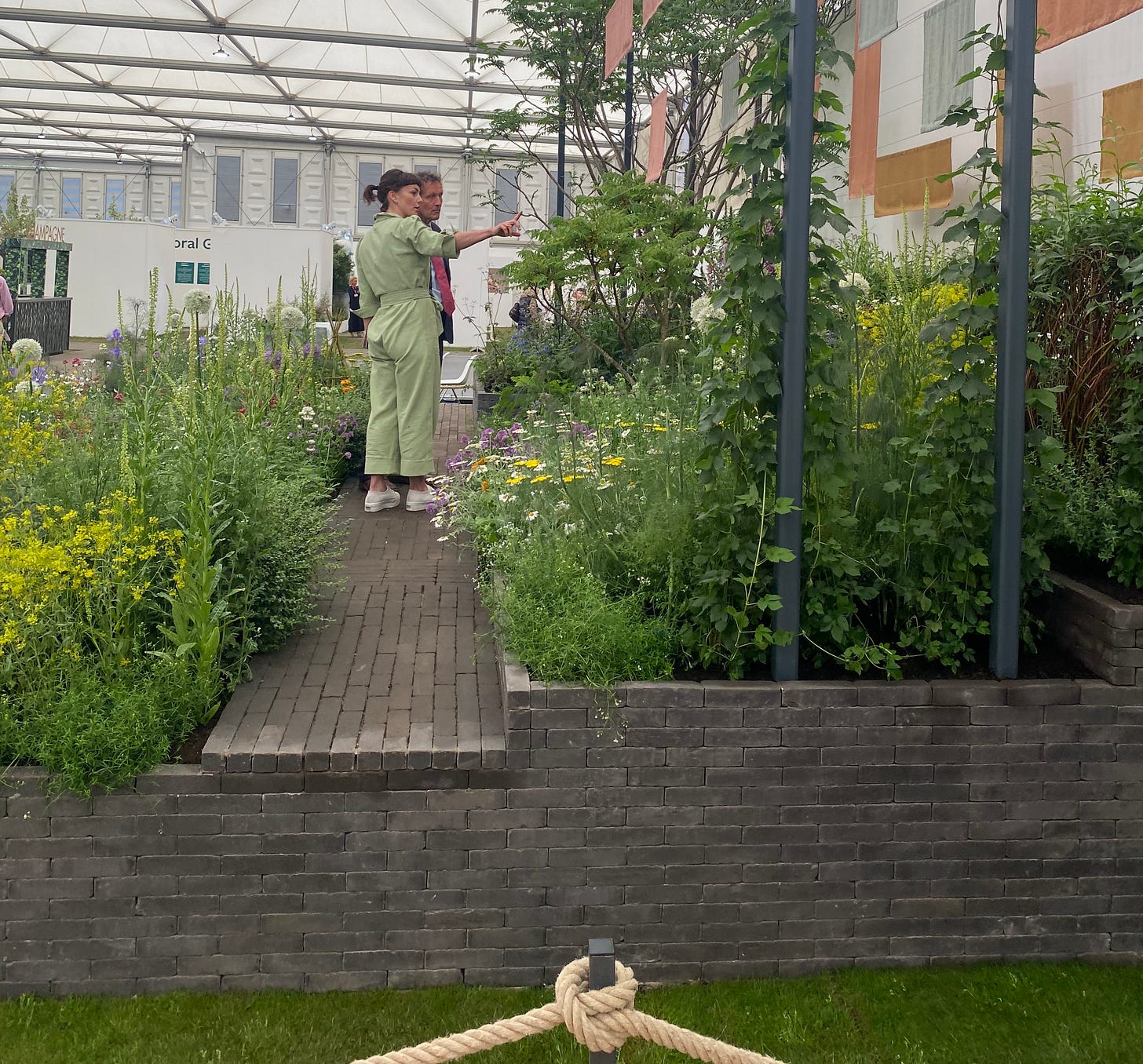
Before the start of the flower show, fellow garden writer and Substacker Boaz Frankel, a friend from across the pond, tasked me with getting a selfie with Monty Don. Sure, I thought, why not? How hard could it possibly be?
Well let me tell you how hard: impossible. I genuinely believe that I had a better chance of climbing into the royal golf buggy on Monday afternoon and going for a joyride with Her Maj than of getting anywhere near Monty. The same goes for Carol Klein.
Out in the real world, they’d barely pass muster as B-list celebs. But among horticulture hobbyists they are Zeus and Hera, and Chelsea is their Mount Olympus. We are but their worshipful devotees, taking shaky photos from behind a security rope.
So in short: sorry Boaz, no selfie.
Lesson #4: But some celebs are a little more approachable
You can keep your Alexa Chungs and Calvin Harrises: I’ll take Dom and Will from The Repair Shop, any day.
Lesson #5: I really, really want a water feature
From 15ft-high waterfalls to gently babbling brooks, every single one of the big show gardens – and most of the smaller ones too – contained some sort of water feature. Even amid all the hustle and bustle and jostling for position, when your ear tunes in to the trickle of water, it instantly soothes the soul. We don’t have a water feature in the garden at home – I’ve always told myself that we simply don’t have the space. Well, I am going to make the space.
Lesson #6: People find controversy in the strangest places
You may be aware that this year’s Best in Show – a prestigious prize given to what a panel of RHS judges deem to be the finest show garden on Main Avenue – was awarded to ‘A Rewilding Britain Landscape’ designed by Lulu Urquhart and Adam Hunt. You may also be aware that this, apparently, has been a controversial choice.
In case you’ve missed any of the coverage, here’s a bit of background: the Rewilding Britain garden imagines the reintroduction into a landscape of a keystone native species – the beaver. All of the plants, too, are native species. When I first saw the garden on Monday, I was struck by its natural charm, its tranquil aura, and of course its important message.
But not everyone agrees. I’ve heard numerous visitors “accuse” the RHS of making a “woke” choice, in declaring this garden Best in Show. (I hate the weaponisation of the word woke, by the way, but this isn’t the time or place to get into all of that.) Meanwhile, Monty Don too, who is, let’s not forget, the most influential voice in the gardening world, has also been outspoken on this matter, calling this not a garden, but a landscape.
Well, I’m sorry, Monty, but none of these are gardens. The Chelsea show gardens have no history; many have no future – at least not on this site, though certain elements may eventually be reinstalled elsewhere. No, they aren’t gardens – they are installations. Displays. Works of art. Elaborate examples of plant-based storytelling.
And even if they are gardens, then Rewilding Britain is as much a garden as any of the others. There’s a water feature, a seating area, and a mesmerising tapestry of trees, shrubs, grasses and perennials. What more do you want? The designers didn’t ship in a team of beavers to construct this landscape for them; they planned it using sophisticated software, they commissioned growers, hired contractors, enlisted volunteers, just like all of their neighbours on Main Avenue.
As for Monty’s general dismissiveness towards the Rewilding movement? Well I’m afraid, as wise as he is when it comes to gardening, he simply doesn’t understand what rewilding is all about.
The rewilding movement is not demanding – or even asking – people with small residential gardens to hand these over to nature. They are not saying: “Down tools! Stop gardening!” Their hope is that major landowners, in what is one of the most wilderness-deprived nations on the planet, might be moved to turn some portion of their land into a sanctuary for wildlife, in a structured and meticulously managed way.
Five days in, and I feel more strongly than ever that the Rewilding Britain garden is the best show garden here. Whether it’s a landscape or an installation or a campaign statement or a garden, I don’t much care. What strikes me is that it is the most beautiful and the most inspiring space, and I’d be ecstatic to walk out into it from my back door.
Lesson #7: Cornus kousa is all the rage, darling
Trends are fascinating phenomena. Where do they come from? Is there some secret society, some sinister cabal of lizard people who decide, “lupines are out, geums are in”? I don’t have a good answer for that, though I strongly suspect: yes.
And I tell you what, those lizard people have a good eye. Fair play to them, I say. Especially when they have apparently convinced every designer at Chelsea to include a Cornus kousa in their planting plans. It’s a beautiful tree, with eye-catching, four-pronged, creamy-white bracts.
Lesson #8: For scent, you can’t beat roses
Considering that this is a flower show, you might expect the air at Chelsea to be thick with perfume. It isn’t. Every now and then you might catch a whiff of someone’s generously applied eau de toilette, or even the toilettes themselves, but floral notes on the nose, not so much.
Until you step into the Great Pavilion, that is, whereupon a rich, sweet scent hits you square in the nostrils. The source of the aroma: twin displays from Peter Beales Roses and David Austin Roses. Full of colour and romance and of course that delicious smell, it’s little wonder they are two of the busiest displays at the show.
Lesson #9: My Gardeners’ World debut was a bit of an anticlimax
This is a photo of me (OK, the mostly obscured side of my head) talking to a very tall Stephen Merchant, as captured by the eagle-eyed camera people of the BBC Gardeners’ World crew. It’s not the appearance I was hoping for, but hey, there’s always next year.
I hope you’ve enjoyed reading this special Chelsea week coverage as much as I’ve enjoyed producing it for you. This feels like as good a time as any to remind you that The Earthworm is a reader-supported publication – please do consider upgrading to a paid subscription, to help me bring you more of this sort of thing in the future. Either way, thanks for reading.

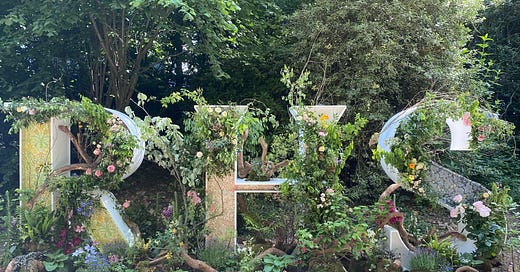



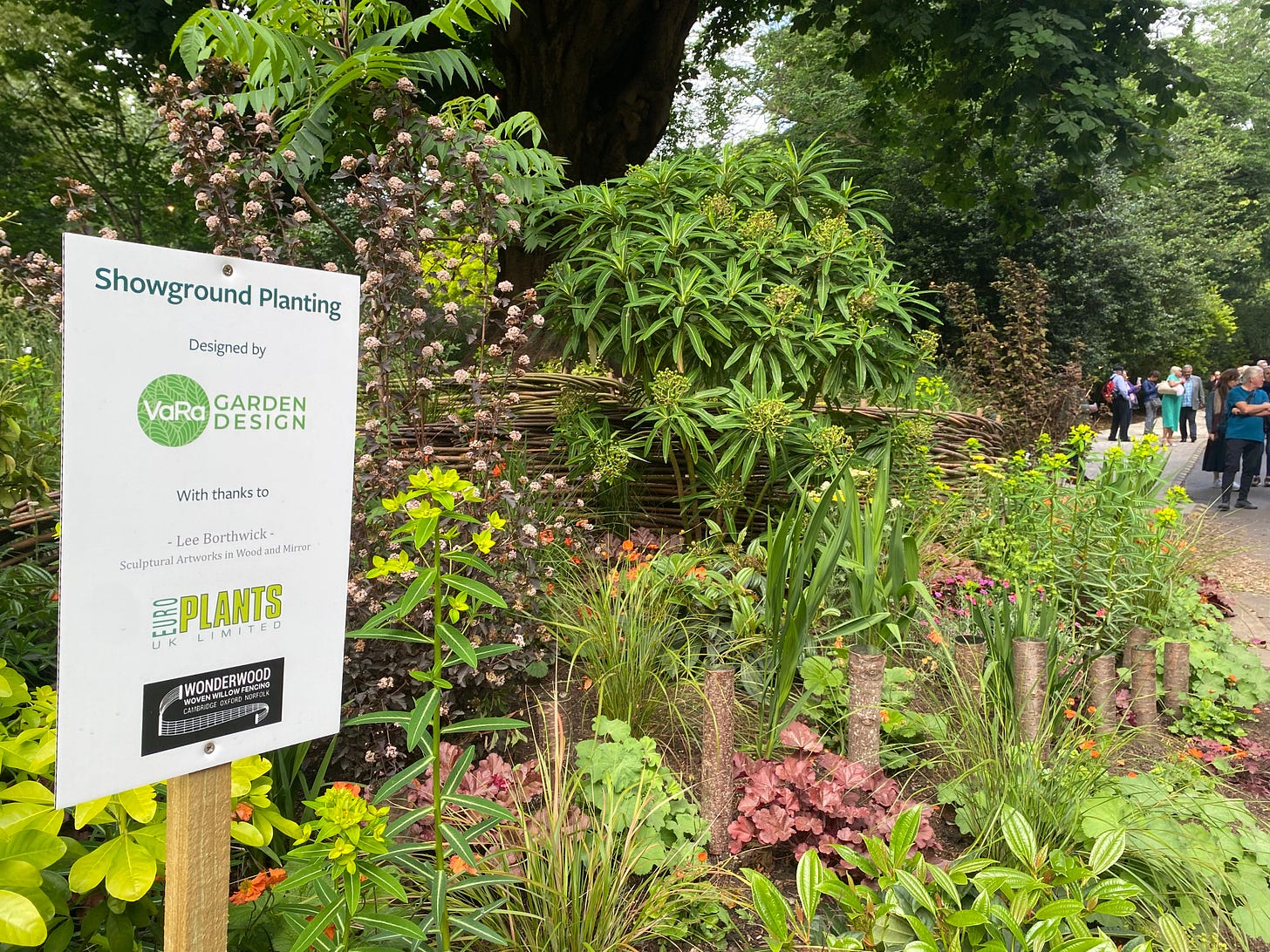
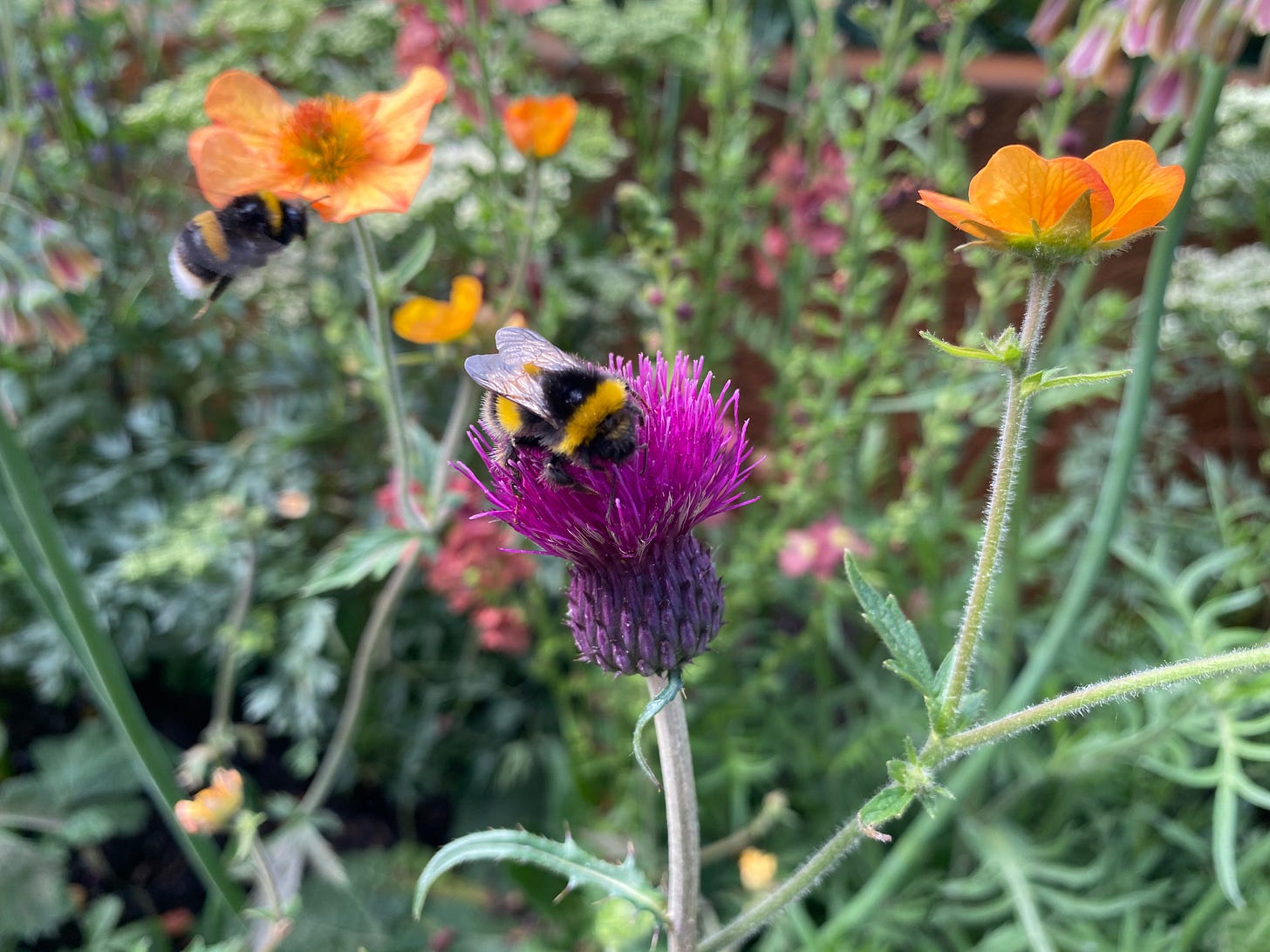

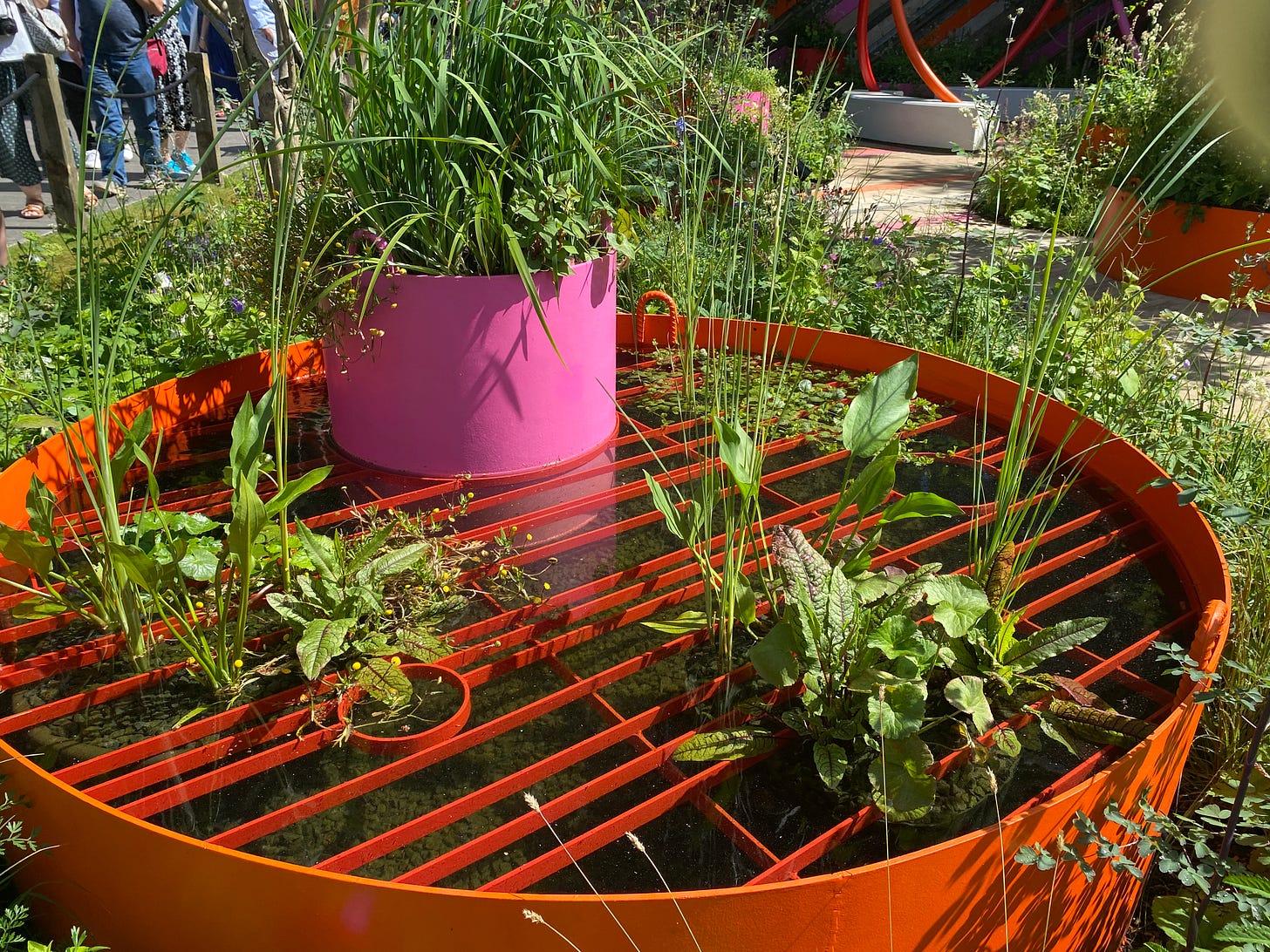
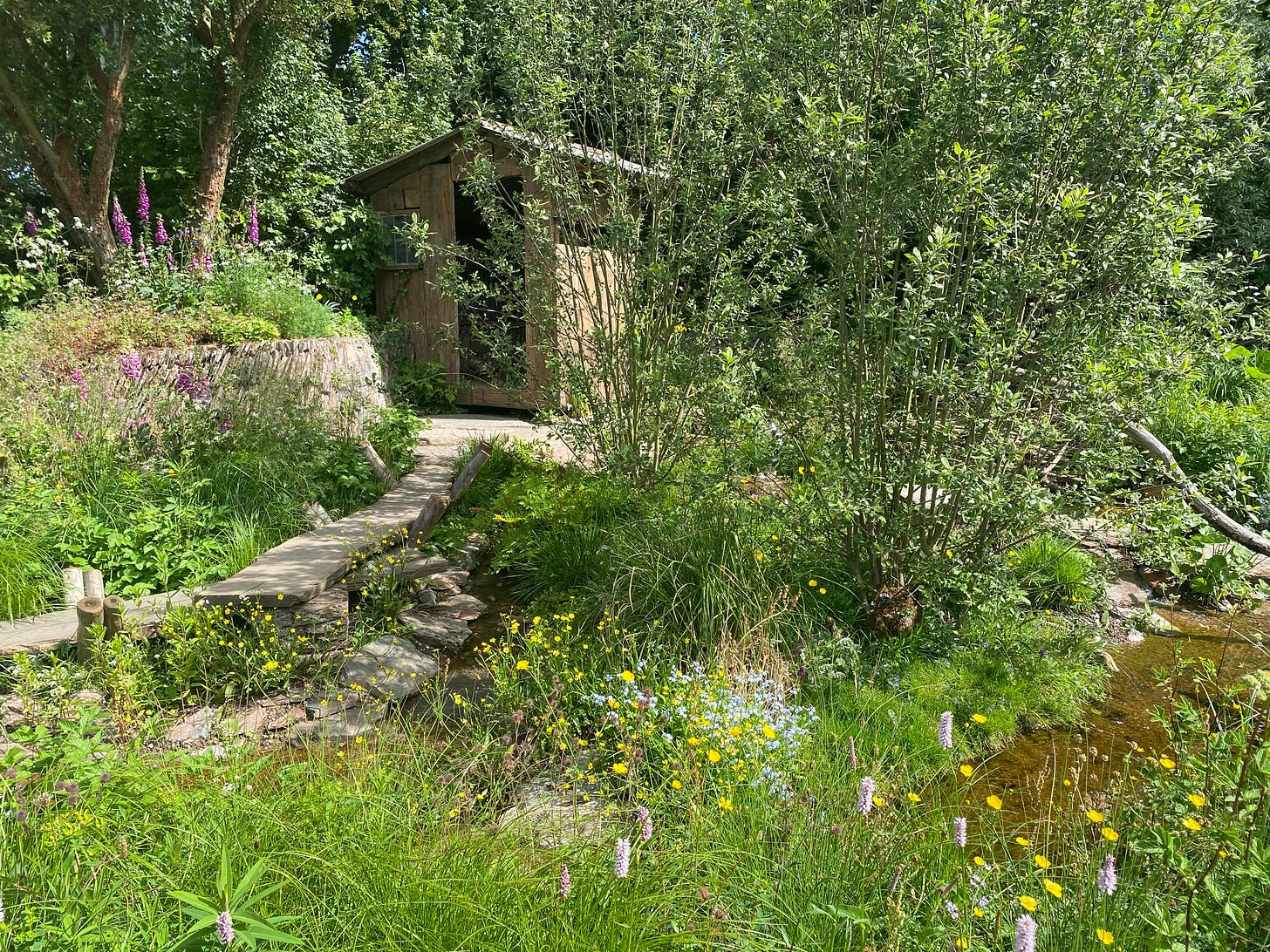

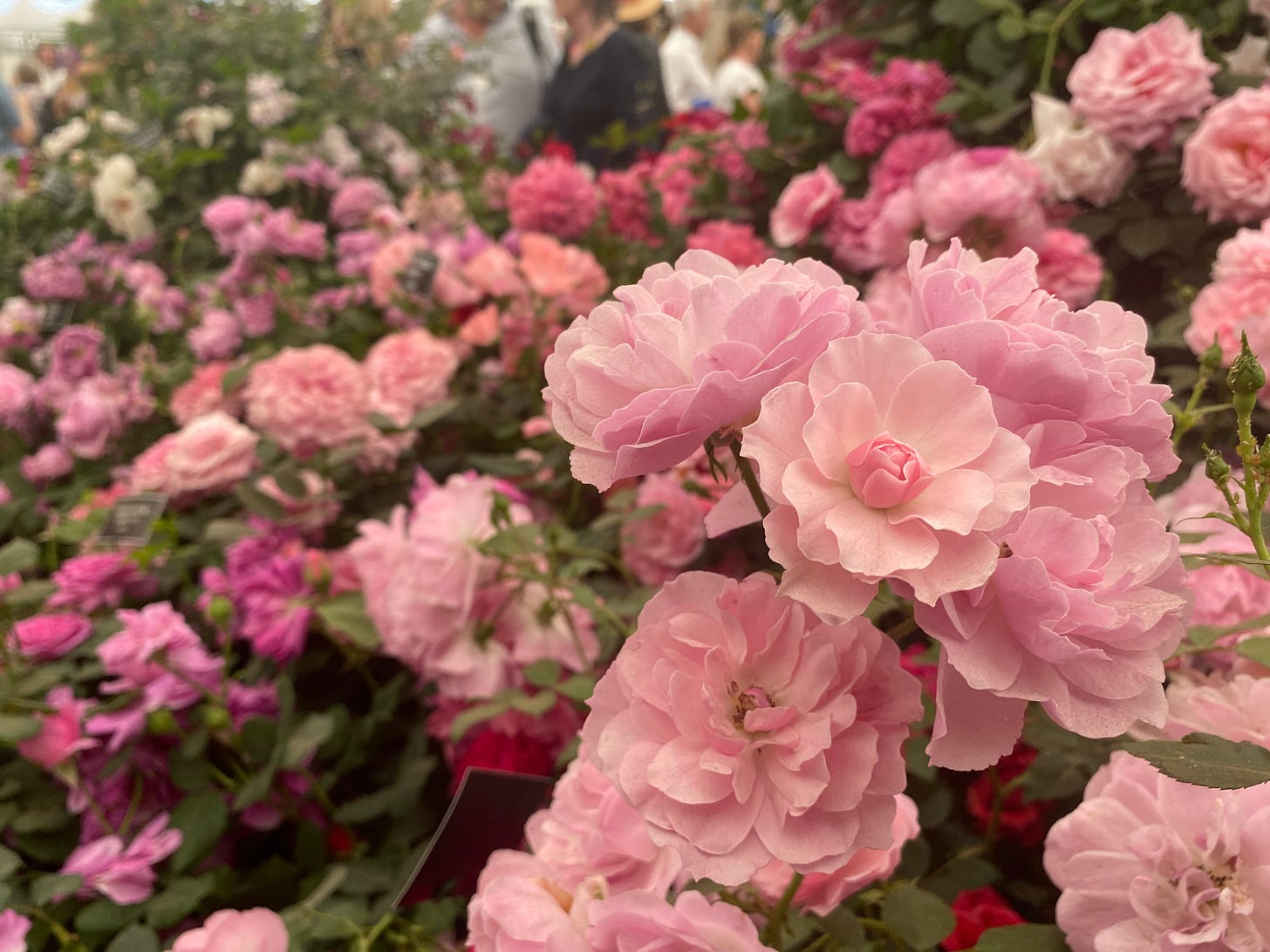

I LOVE this post! And not just because I get a mention in it! So much to chew on here. I love your thoughts about none of these show gardens actually being gardens. You're absolutely right that gardens need a past and future and these theatrical groupings of plants are mere botanical blips. If one of these "gardens" does anything to encourage more sustainable land practices then that certainly seems like a win.
And while I'm sad to hear that you didn't share a tea (or champagne) with Monty or Carol, I'm very impressed with your Repair Shop selfie AND the media coverage of you hanging out with Stephen Merchant! Very cool!
Next year, I'm flying over for the show and we'll show up on press day with matching shirts emblazoned with Monty's face. Then he'll probably want a selfie with us.
I would love a post about water features! I also want one, I also think my garden is too small. I’d love to see some inspiring solutions. Especially that are wildlife friendly and low-maintenance; we have an allotment garden 3km from our house so we’re not there every day to refill or clean water. I’ve dreamed about a tiny pond but got intimidated. Thanks for any practical advice!